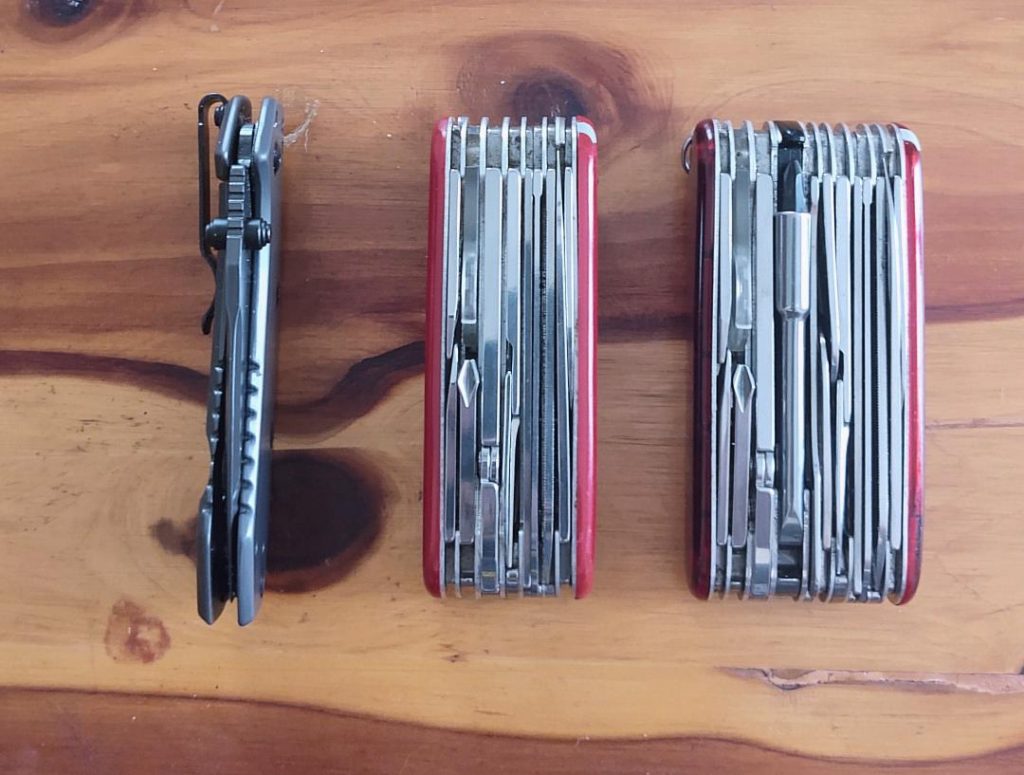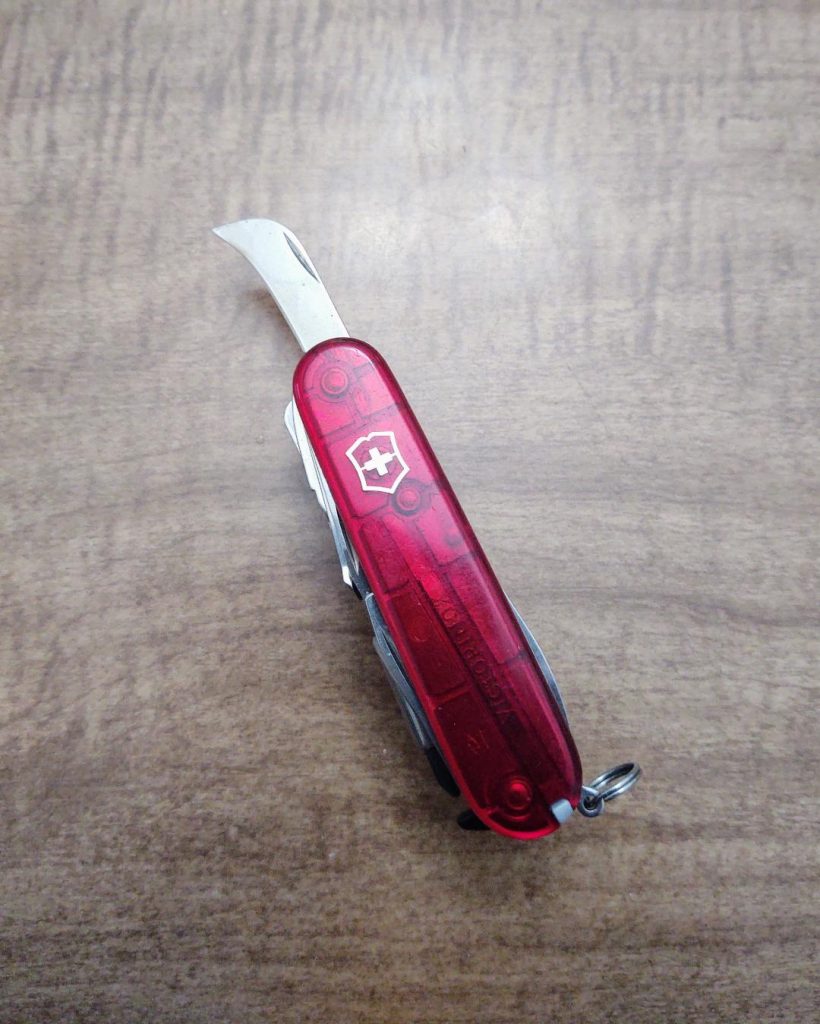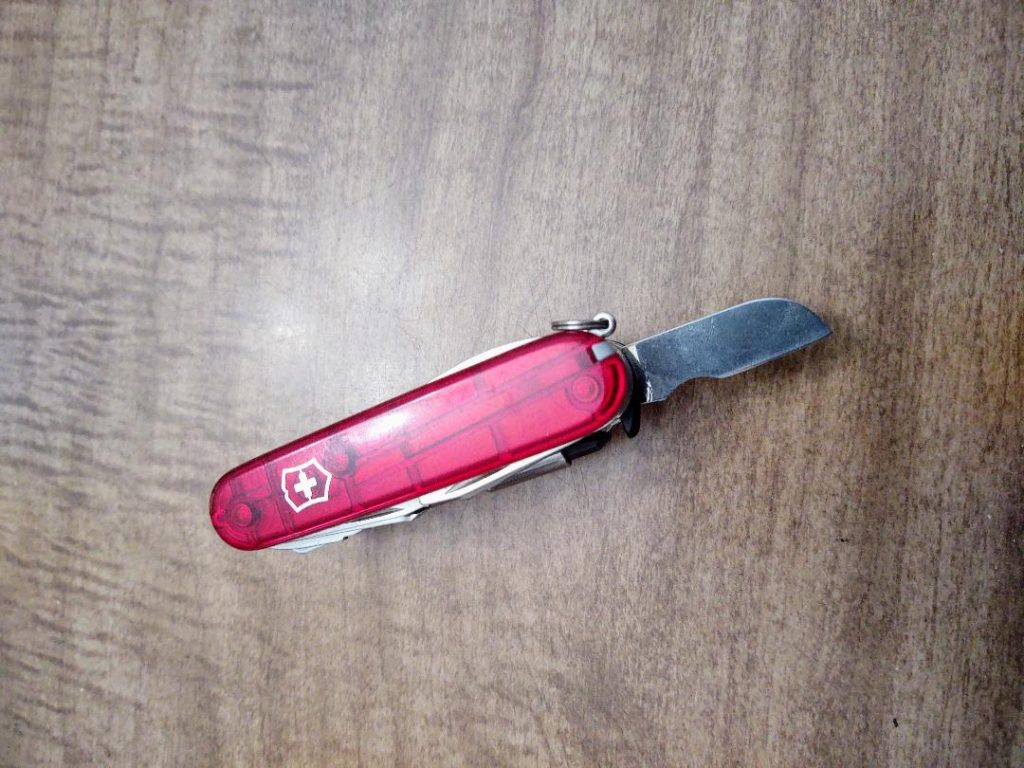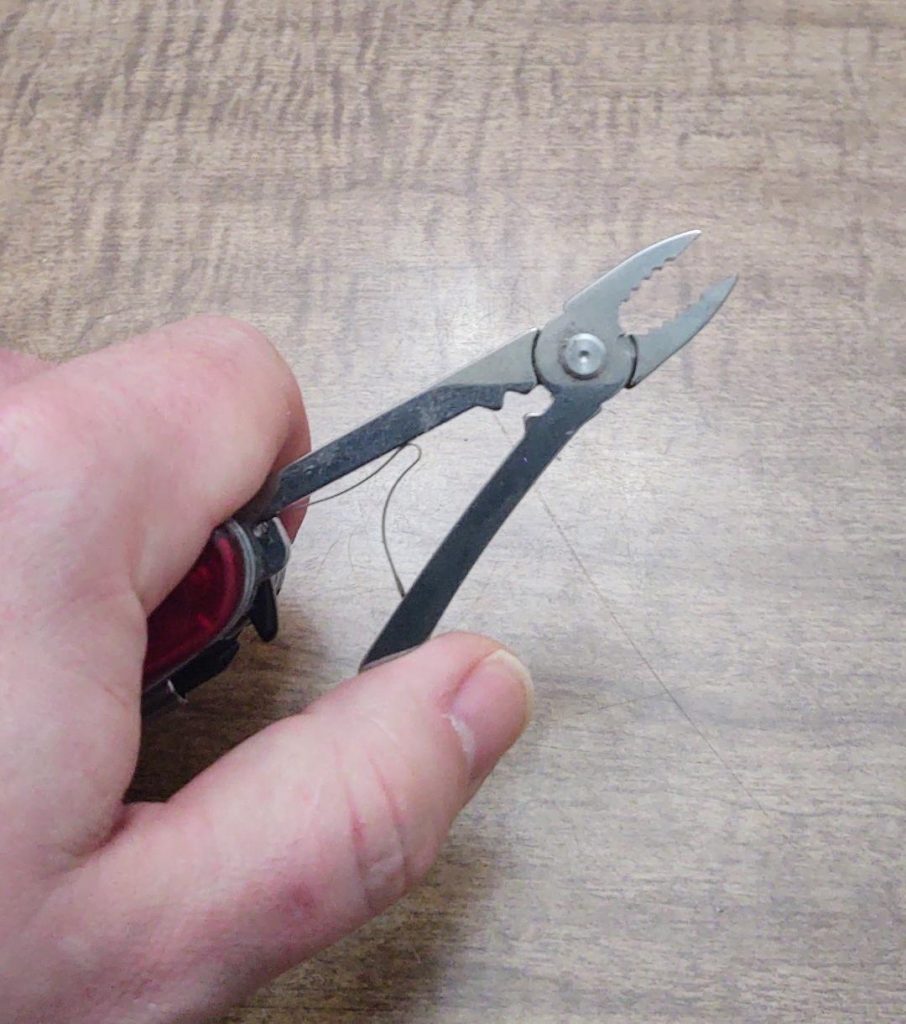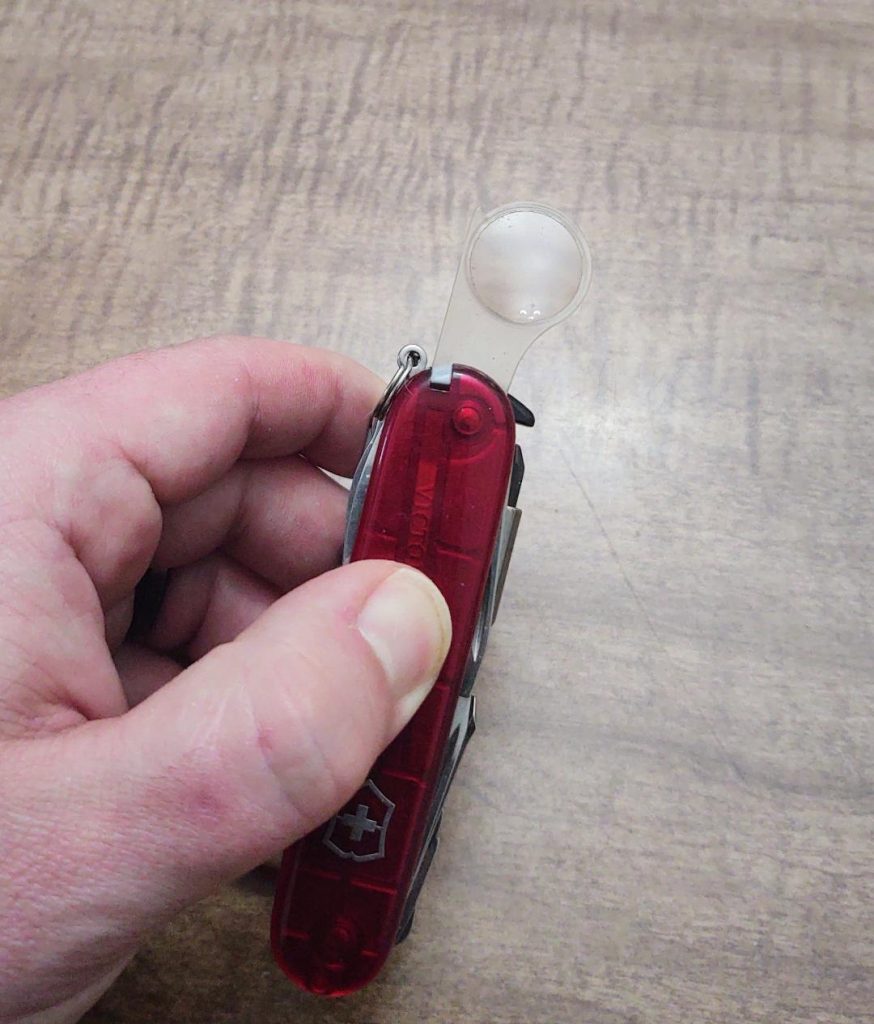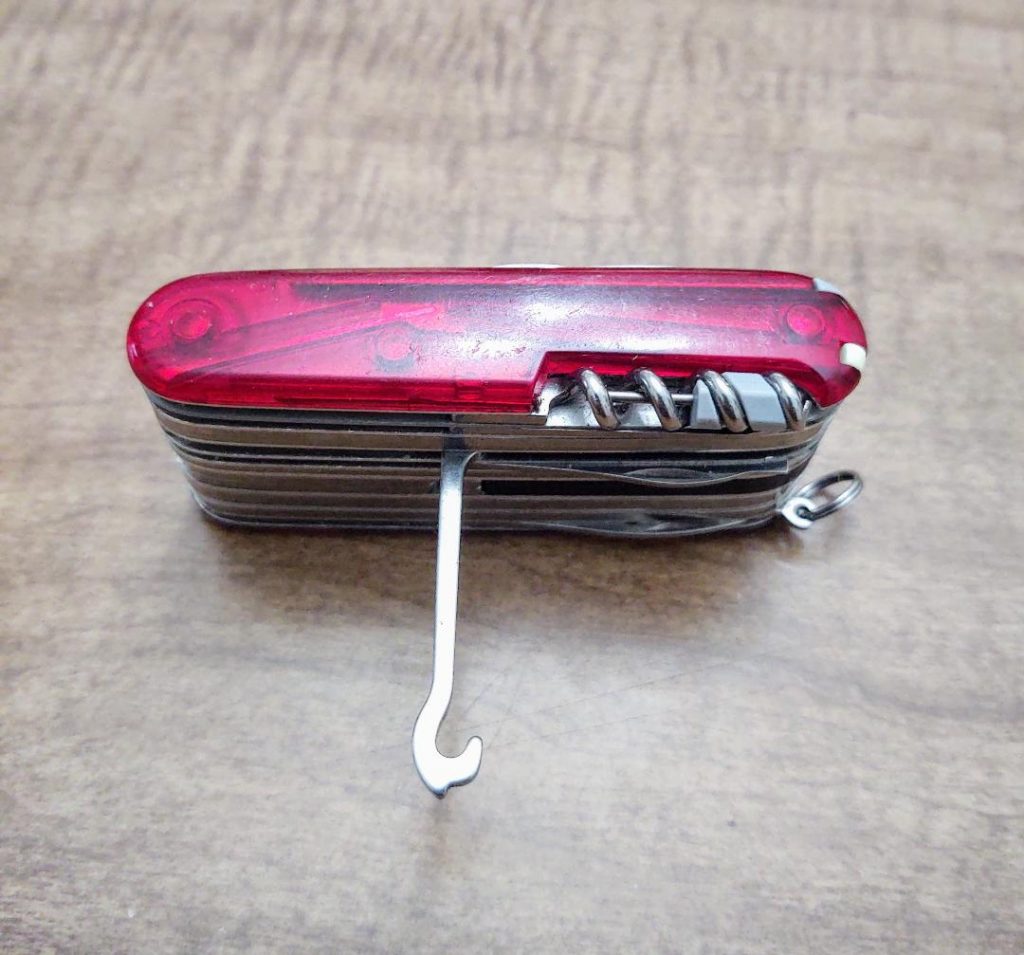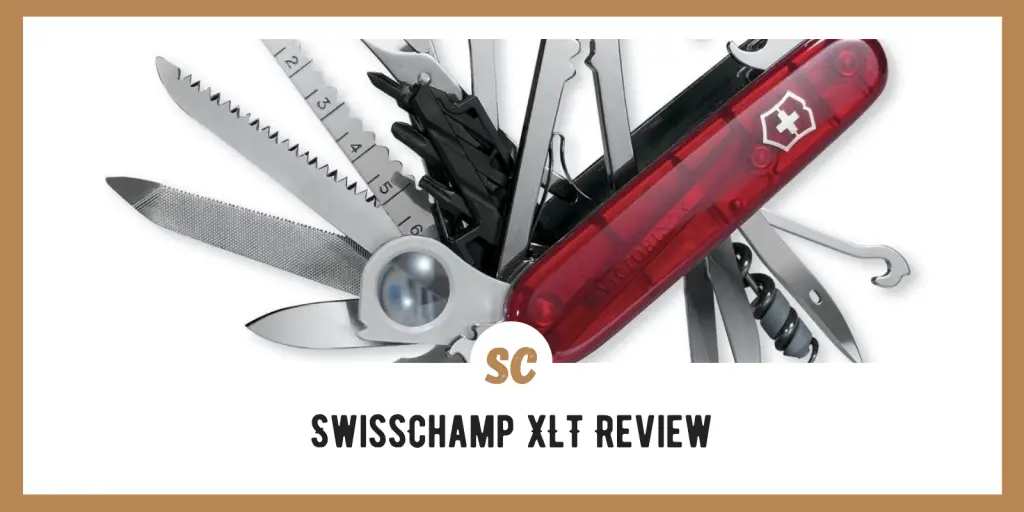
I have been a big fan of Swiss Army Knives for my entire life. One of my all-time favorite models is the Swiss Champ and that is why I am excited about today’s article because I will be reviewing the Swiss Champ XLT. The XLT is kind of the big brother to the Swiss Champ because it is larger and comes with the addition of a few tools that the regular model does not have.
I did want to say that this review is quite a bit longer than most of my reviews because there is so much to cover with this pocketknife. If there are parts of this knife you are more interested in than others, you can skip to those sections by using the quick navigation bar on the page.
To begin let’s go ahead and take a look at a few specifications and features of the Swiss Champ XLT.
- Sport type: Camping & Hiking
- FIT FOR ALL TASKS: At their heart, all our pocket knives are a survival tool; multitaskers that...
Last update on 2024-04-22 at 23:12 / Affiliate links / Images from Amazon Product Advertising API
SKIP AHEAD
Specifications
Dimensions
The Swiss Champ XLT measures in at 1.7 inches tall, 3.6 inches long.
Weight
8.7 ounces
Scales
The scales are made from ABS/collider and only come in a transparent red color.
Features
Below is a complete list of all the tools or functions that come with this knife. I obtained the list and the above specifications from Victorinox’s website.
- Reamer, punch, sewing awl
- Can opener
- Screwdriver 3mm
- Bottle opener
- Screwdriver 6mm
- Wire stripper
- Philipps screwdriver ½
- Magnifying glass
- Pliers
- Wirecutter
- Wire crimping tool
- Screwdriver 2.5mm
- Pruning blade
- Electrician’s blade
- Wire scraper
- Pharmaceutical spatula
- Multipurpose hook
- Scissors
- Fish scaler
- Hook disgorger
- Ruler (cm)
- Ruler (inches)
- Wood saw
- Chisel 4mm
- Nail file
- Nail cleaner
- Metal saw
- Metal file
- Large blade
- Small blade
- Bit wrench
- Keyring toothpick
- Toothpick
- Tweezers
- Pressurized ballpoint pen
- Pin, stainless steel
- Mini screwdriver
- Corkscrew
- Bit slotted 4
- Bit Phillips 2
- Bit Phillips 0 (Pozidrive)
- Bit Phillips 1 (Pozidrive)
- Bit Torx 10
- Bit Torx 15
- Bit case
- Female Hex drive 5mm for D-SUB connectors
- Female Hex drive 4mm for bits
- Bit Torx 8
- Bit Hex 4
Hands-On
The first thing that I wanted to point out about a knife like the XLT is that it is not just a knife, but a multitool. This might seem obvious, but I think it is an important distinction to make because knowing this will offer you a better understanding of what it is and is not capable of.
With that in mind, I’m going to go ahead and jump right into my thoughts about Swiss Champ XLT after using for more than a year.
Size
Right off the bat, it is easy to notice the size of the XLT. It is not that it is so much longer than most pocketknives, but it certainly is wider and heavier.
Here is a quick photo to show you what I mean. On the left is the Kershaw Cryo, which is the style of pocketknife I think most people are accustomed to. In the middle is the regular Swiss Champ, and on the far right is the Swiss Champ XLT.
I am used to carrying multitools in my pant’s pocket, so I have no issues with carrying the XLT in that fashion, though it is a bit bulky at times. However, I could see how carrying this model in a pocket could be uncomfortable, especially for people that normally carry a knife with a slimmer profile.
I find the best way to carry this knife is either in the pocket of a bag, jacket, or in a pouch that can be attached and carried on the beltline. Personally, I like carrying it on the beltline because it keeps the tool readily available.
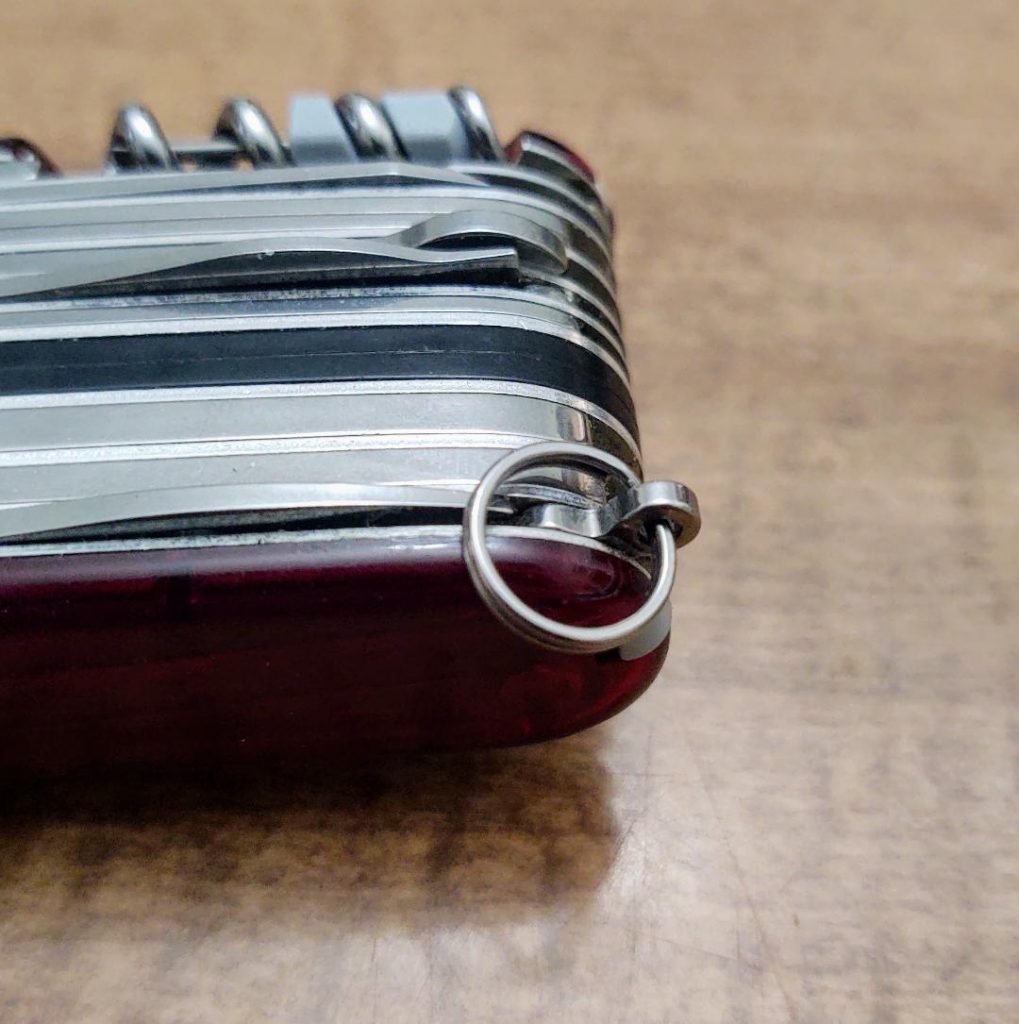
Keyring
I like that many Swiss Army Knives, such as the XLT, come with a keyring for keeping several items organized together. It also allows me to quickly attach or detach the knife to the outside of a bag. Given the weight of this knife, I would use caution hanging it from something like a vehicle ignition.
I don’t tend to use the keyring for carrying keys or other similar items. Instead, I use it as an attachment point for carrying it or securing it away at the end of the day.

Scales
The red ABS scales are transparent and offer a glimpse inside of the frame of the knife as well as some of the miniature tools encased inside, which I think is an interesting style. They are completely smooth and don’t offer much in the way of grip but with as big as the knife is there is plenty to hold onto.
I have had this particular model for over a year and have shuffled the knife from my pocket, bag, vehicle, and have even dropped it a few times. There are a few visible dings but overall I would say the scales have held up well.
Blades
One of the features that stands out on this model is that it doesn’t come with just one knife blade, not even two or three, but four blades!
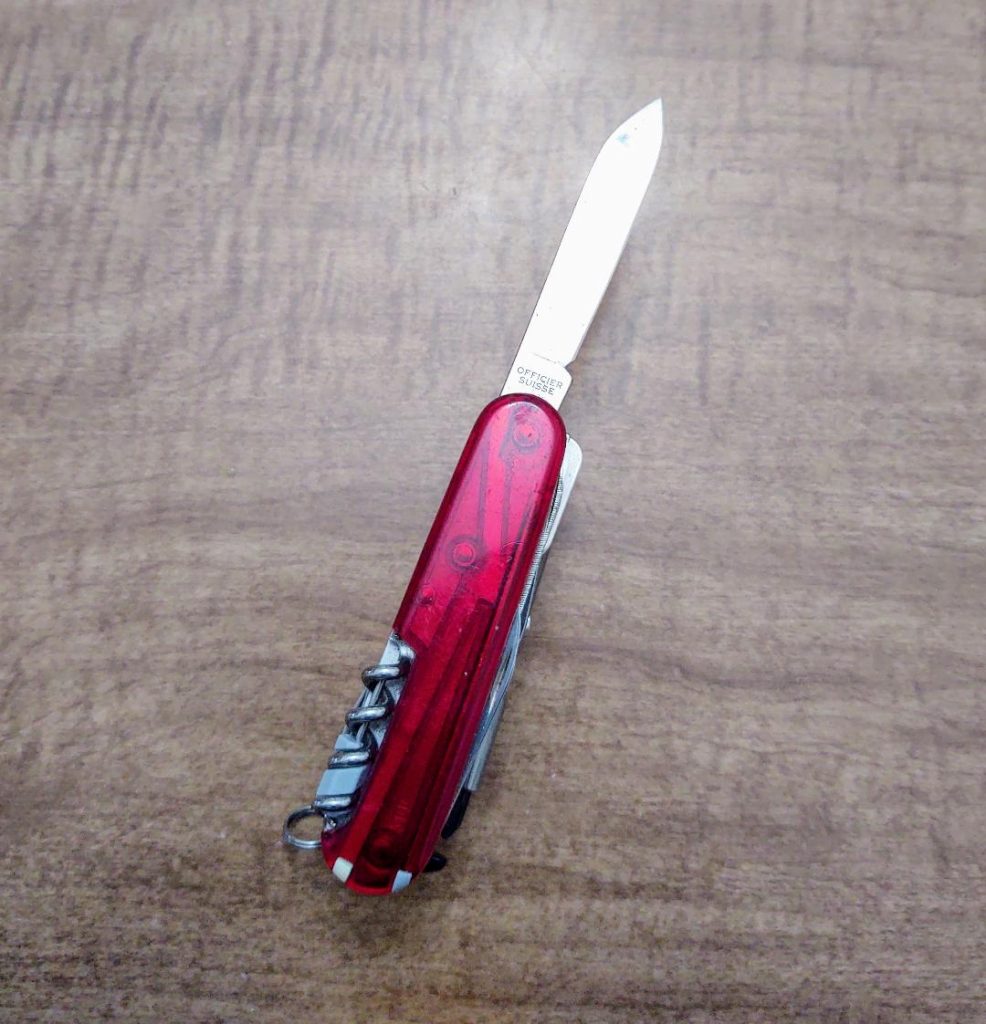
On one side of the knife is a large and small blade that can be found on most Swiss Army Knives. The large blade is great for general purposes tasks while the small blade works well for tasks that require a little more control or attention to detail.
The other two blades, a pruning blade, and an electrician’s blade can be found near the center of the frame. The pruning blade has a very noticeable curve to it while the electrician’s blade is somewhat short and stubby.
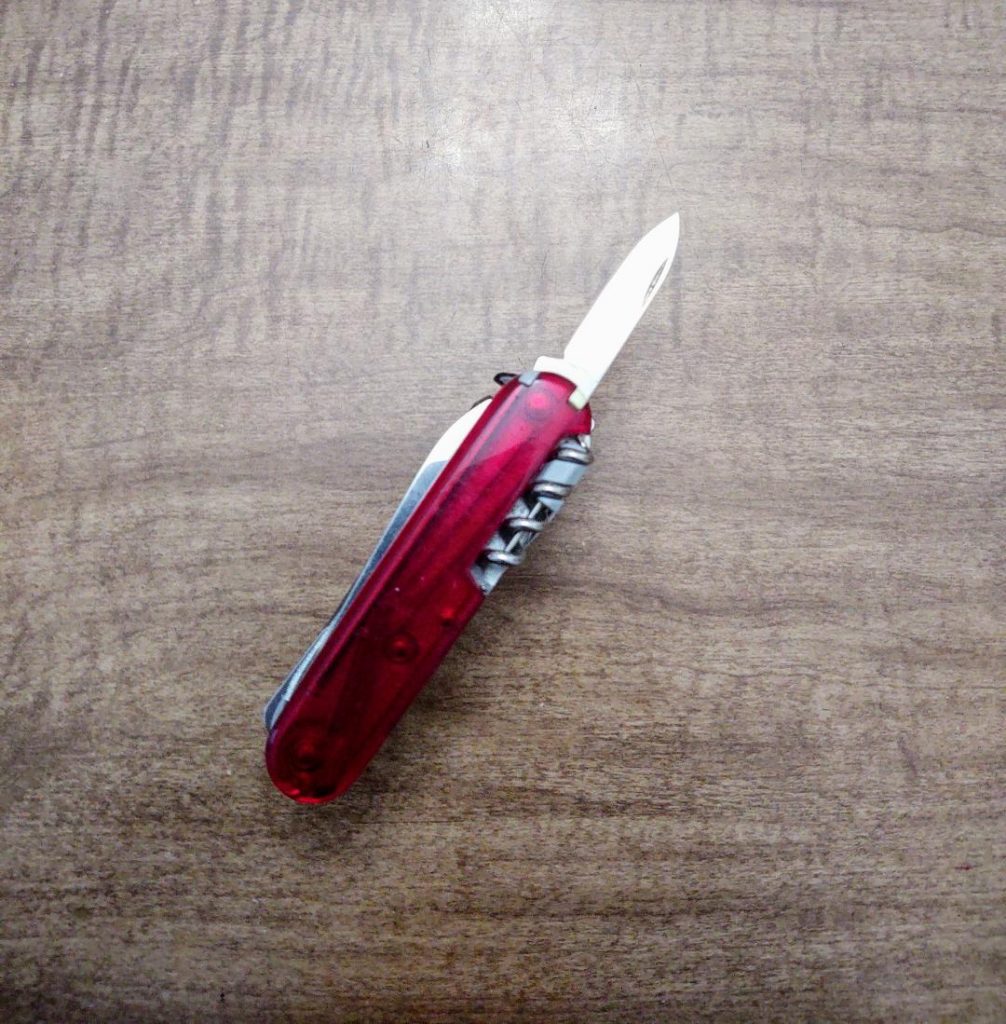
The electrician’s blade has a very straight cutting edge without much of a tip. I like this design because it allows me to use this blade for making precise, straight cuts. For example, this blade is great for making notched cuts in wood.
As you may have noticed from the pictures, none of the blades on the Swiss Champ XLT are serrated. There is a time and a place for serrations on a knife, but I am not a big fan of them. Plus, a knife without serrations is much quicker and easier to sharpen.
Having four different blades on this knife has been nice because it gives me options depending on what I am working on. Also, if I primarily only use one blade I will have three backup blades that will always be sharp.
A quick safety note, when the blades are extended into the open position, they will snap firmly into place. However, the blades, as well as the rest of the tools on this model, do not lock into place.
Pliers
The pliers on the XLT are small when comparing them to the pliers of other multitools, but I have been pleasantly surprised with their effectiveness.
I have found that I do not always need large pliers for what I am doing but I still need some grabbing power. These pliers fill in that gap of completing small tasks, like pulling cordages through tight spaces or tightening some piece of hardware.
The way that the pliers are incorporated into the frame makes them extremely comfortable to use. The only downfall of the pliers is that they depend on a small spring for resetting the handle. If the spring is lost, broken, or wears out, it will need to be replaced for the pliers to operate normally.
Seriously, do not underestimate these pliers based on their size, they are far more effective and useful than you would think.
Magnifying Glass
This tool is kind of like the pen in that many pocketknives do not have them. I have known some people that roll their eyes at this tool, but I like that Victorinox added a magnifying glass to some of their models.
I may not use it every day, but I have used it more than I ever thought I would. While my eyes are not that old yet, the print on certain things has gotten smaller and smaller and more difficult to read. It is nice to have for reading the small print on manuals, for making out details on maps, and for locating the odd sliver or two stuck in my hand.
In terms of being outdoors or in a survival situation, the magnifying glass can be used for getting a fire started. The conditions need to be just right, and you will need patience for this method, but it is an effective for starting a fire. It is not always easy, but I have started many fires with this magnifying glass.
The only things I would have changed about this tool are it would have been nice if it were a little bit bigger, which I know would have been difficult, and that the frame was made out of metal instead of plastic. Other than that, I love the magnifying glass.
Multipurpose Hook
I think this is often a forgotten tool on the models that have them because people don’t know what to use it for. I believe this was also called the parcel hook at one point in time because it could be used to hook onto the twine around packages while the frame of the knife was used as a carrying handle.
Nowadays, twine and cordage are not used around packages, but the hook is still quite useful in a lot of ways. It still makes for a great way to carry and hook onto certain items such as a bundle of firewood secured with cordage or to move a hot grill away from the fire.
Wood Saw
I like to spend time outdoors and usually have several projects going at any given time. I enjoy working with wood and tinkering around with it, so I have used the wood saw frequently.
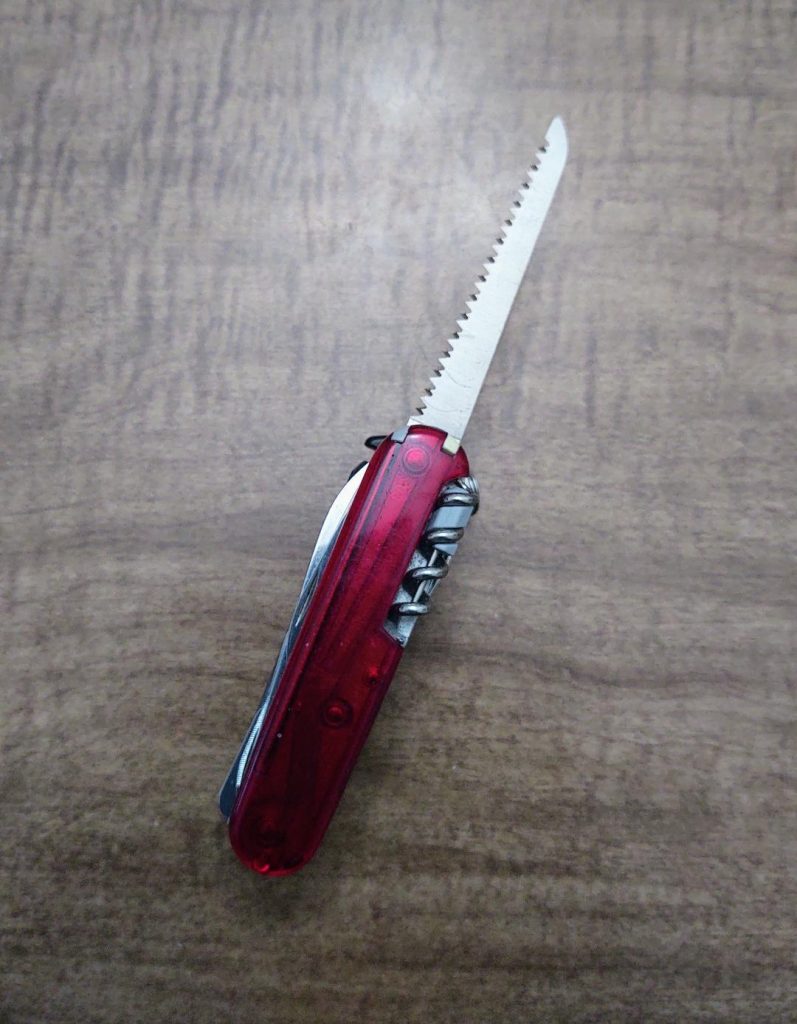
Right out of the box this saw are incredibly sharp, and I have processed a lot of wood with it before it started to show any sign of dulling.
Given the size of the saw, you will not be tackling any large pieces of wood with it, but it is great for trimming branches around the home, hobby work, and creating outdoor projects from wood. I have always been impressed with the wood saws on Swiss Army Knives and this one is no different.
Metal Saw/File
If I had to say which tool I use the least on this knife, this would be one of them. That’s not because the tool doesn’t work, I just don’t work with metal all that often.
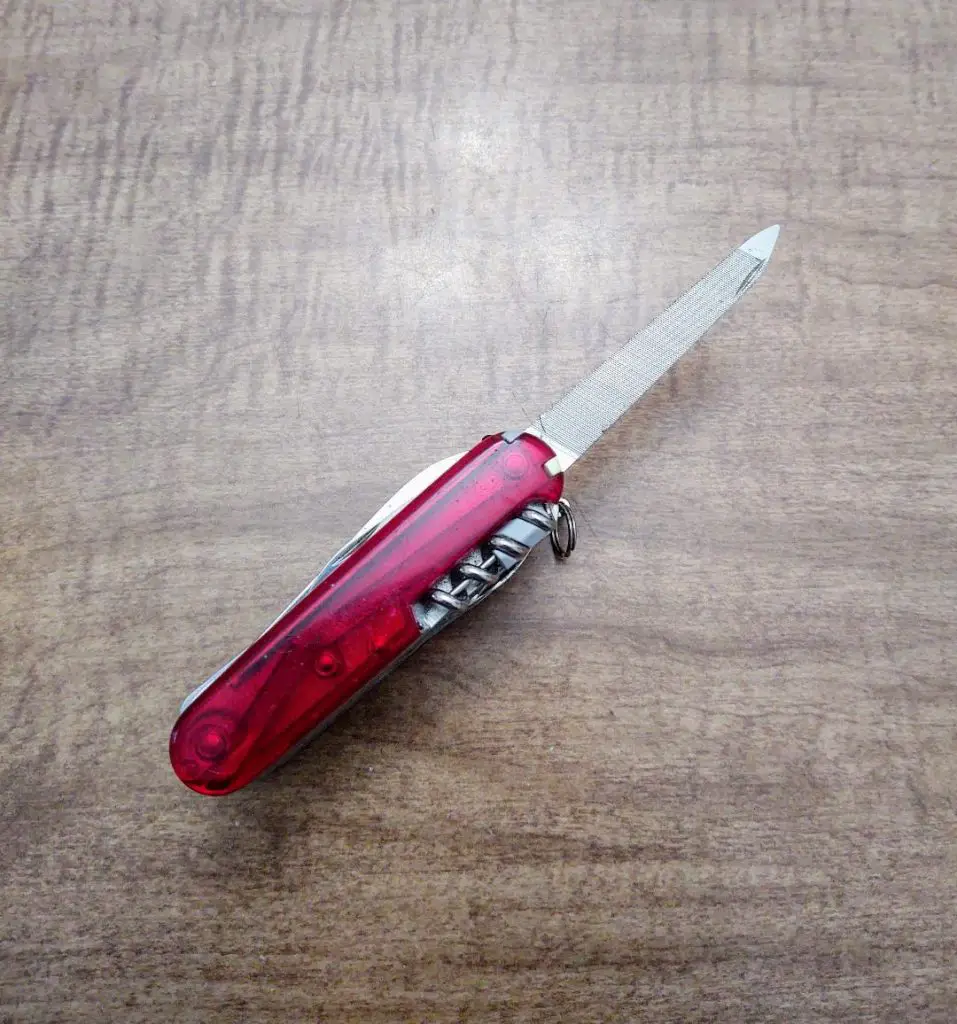
I have used the saw to cut through some aluminum cans and other pieces of thin or soft metal, so it does work in that regard. However, I primarily use the file for removing burrs from surfaces, shaping other knives, and sharpening fishing hooks.
Tweezers and Toothpick
These two tools go hand in hand with Swiss Army Knives. The toothpick is nice to have for after a meal and the tweezers do well at picking up small items where you may not need a lot of grabbing power.
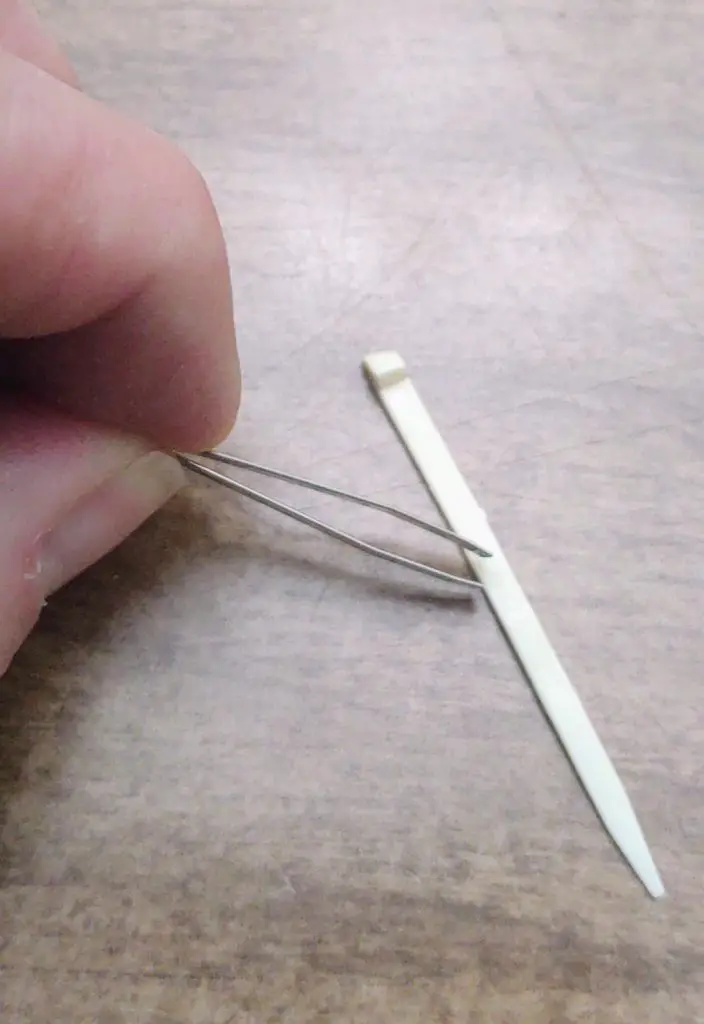
Pressurized Ball Point Pen
Have you ever had a pocketknife with a pen in it? Of course, since I enjoy writing so much I do like this tool, but a pen can be useful for all sorts of reasons.
The pressurized ballpoint pen is located on the side of the red scale and can be taken out by lifting the small grey tab on top.
The pen is quite small and takes a bit of getting used. It only took me a few minutes to find a comfortable way of holding it and once I did, the pen produced a nice bold blue line.
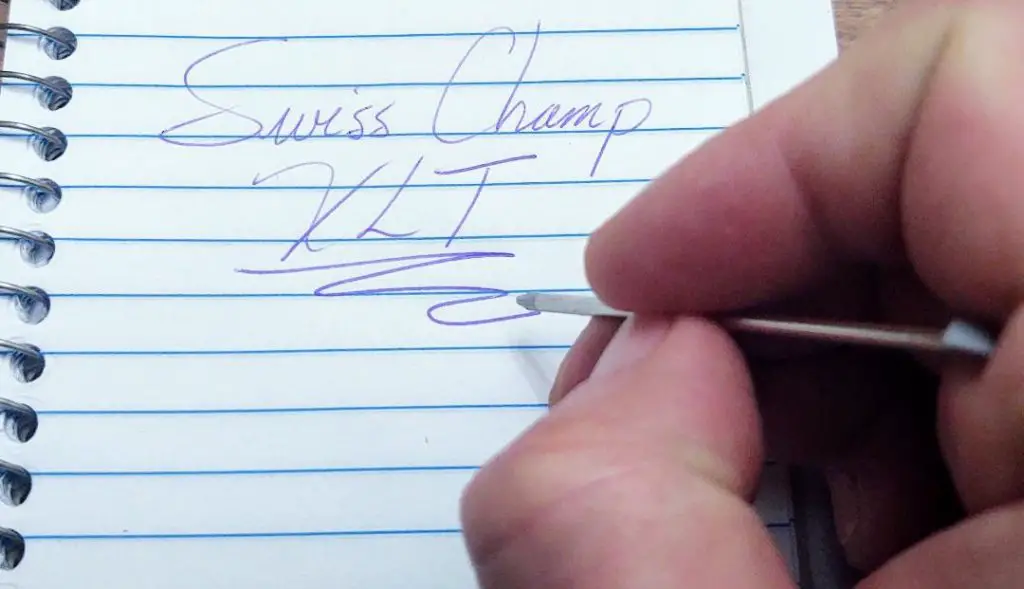
I wouldn’t suggest using this pen for writing out your memoirs but it is handy for jotting down quick notes or messages.
Driver Set
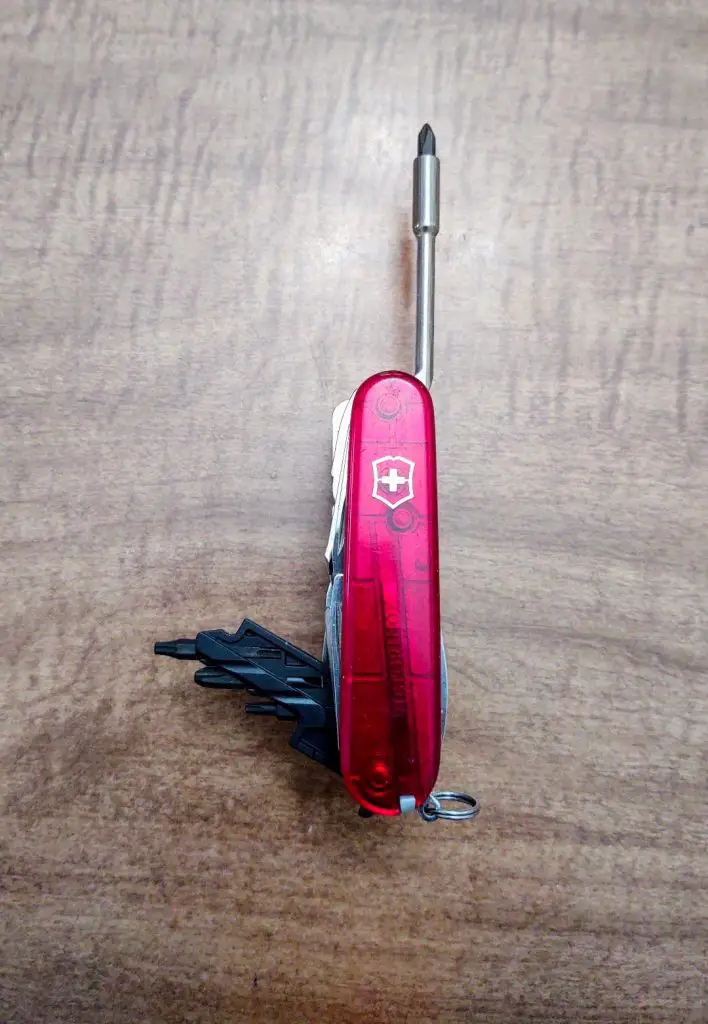
This type of tool is not new to me, but it is new to me in terms of using it on a Swiss Army Knife. At first, I was not sure if I was going to like it or have much need for it. After carrying the XLT around for a while I was yet again surprised at the number of times I have used it.
I would say that most people have a toolbox with larger-sized hand tools because those are what we use most often. I have found that people, including myself, generally lack miniature drivers because they are not used nearly as much.
It’s frustrating to go and replace the batteries in something only to find there is a tiny setscrew preventing access or to make an adjustment to some piece of gear and being presented with the same type of small hardware.
That’s where this tool has come in handy for me, for those tasks that I do not run into everyday where a regular tool may not be available.
Of course, if you deal with small hardware all the time then this tool will probably be great to have by your side. It has five reversible bits and a bit carrying case that folds right into the frame.
Scissors
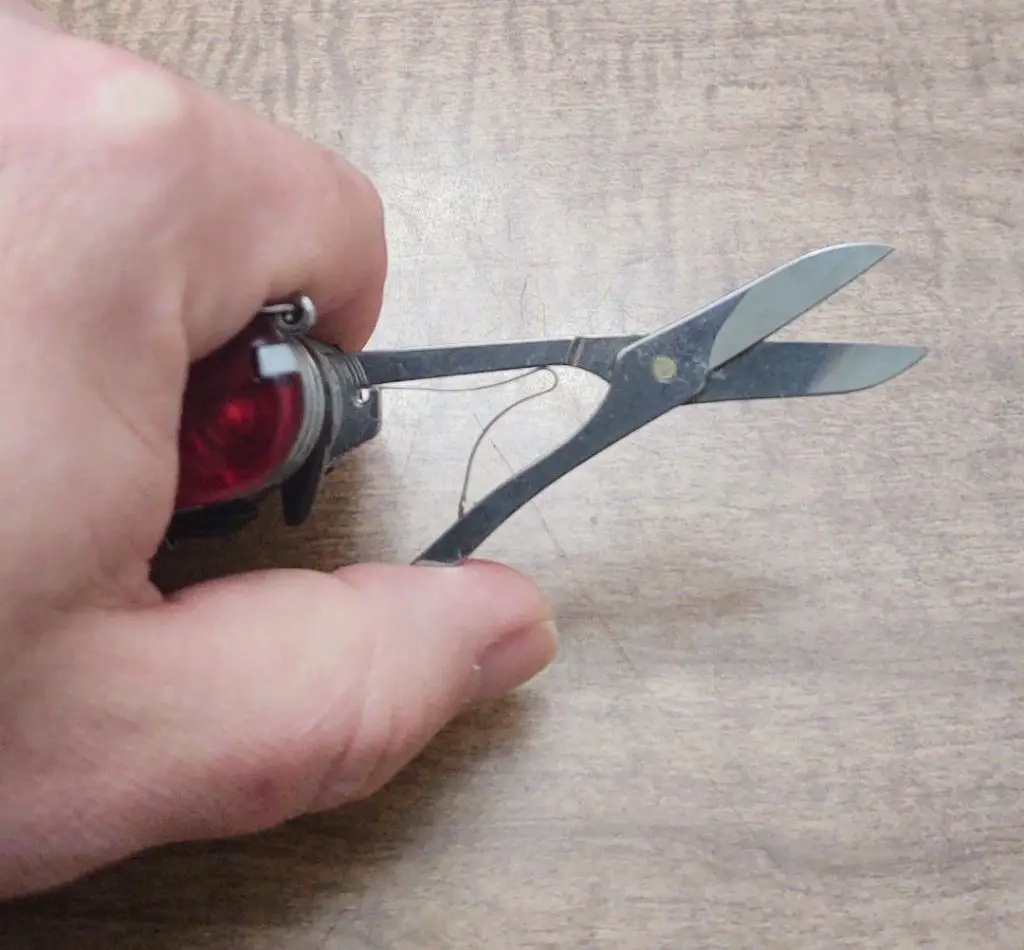
The scissors on a Swiss Army Knife are probably one of my favorite tools. They are incredibly sharp and allow me to perform cutting tasks in a safe manner that I would otherwise have to use a knife for. I use them almost every single day and would feel kind of lost without them.
Like the pliers, the only downfall to the scissors is that they are dependent on a spring for resetting the handle. This doesn’t mean the scissors, or the pliers, will not work without the spring but it will be more frustrating to operate them.
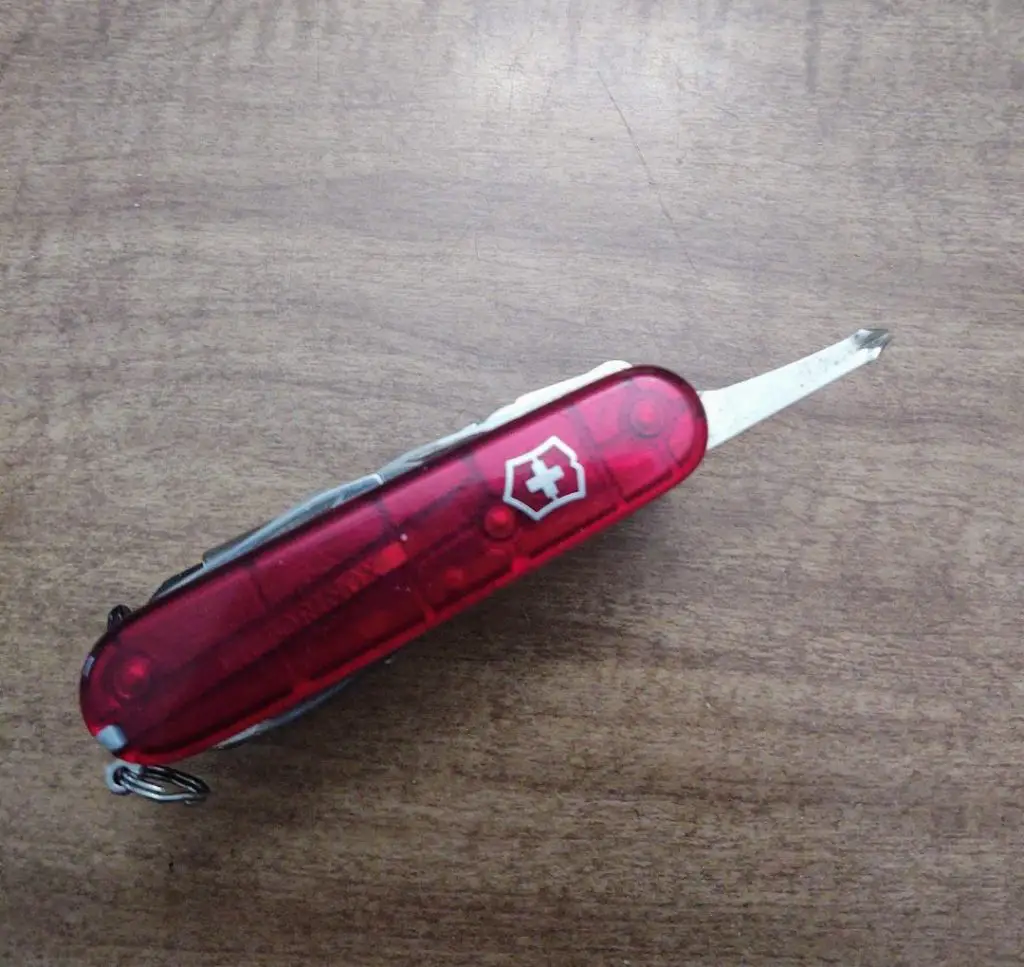
Phillips and Flat Head Screwdriver
I don’t think there is much to say about these two tools. They are small drivers that I have used dozens of times and they work.
Reamer/Awl
The reamer is one of those tools that I may not use all that often, but I am glad that I have it when certain tasks arise. It’s great for poking holes in certain materials, like making a new notch in a leather belt, drilling holes in wood, and sewing.
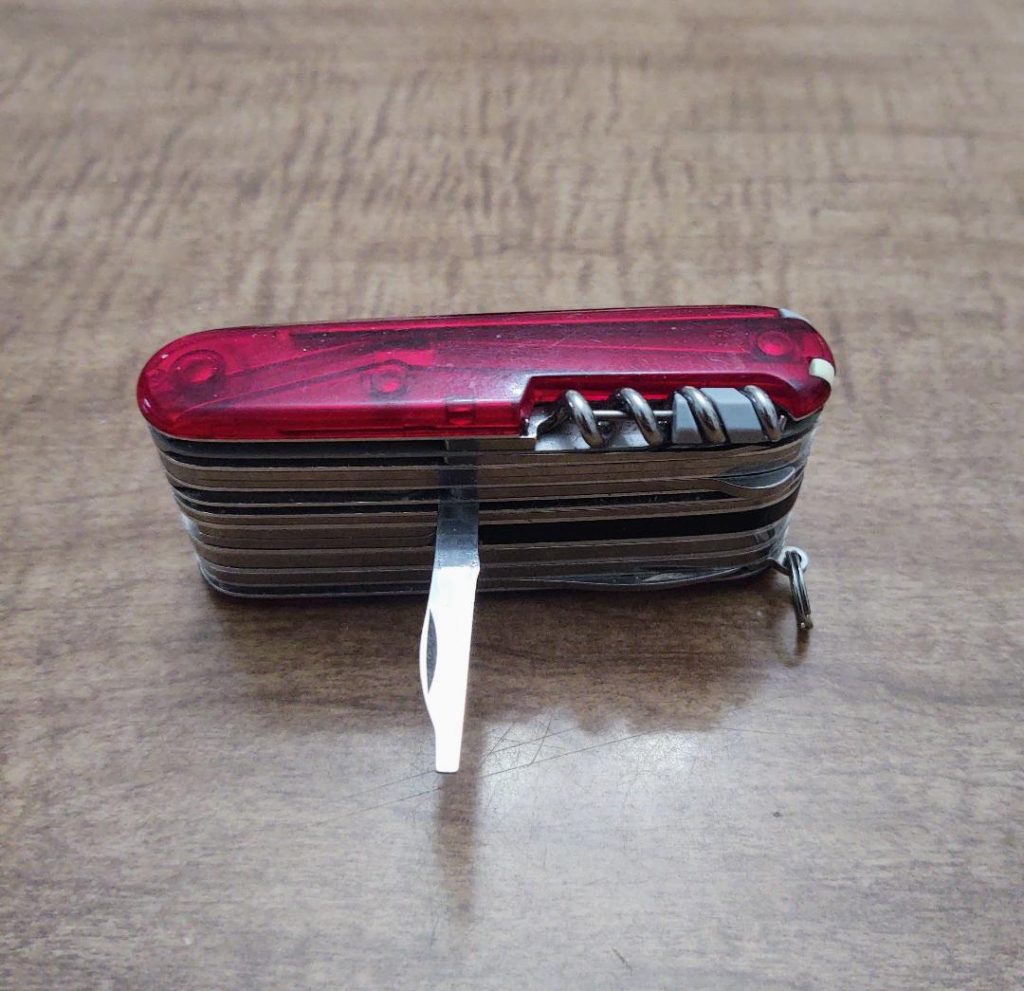
I have also used it quite a bit as a marking tool for imprinting a measurement line onto a piece of material.
Corkscrew and Miniature Screwdriver
Even though I have found some odd uses for the corkscrew I think most people will use it for its intended function. I have rarely used this tool, but it has come in handy several times.
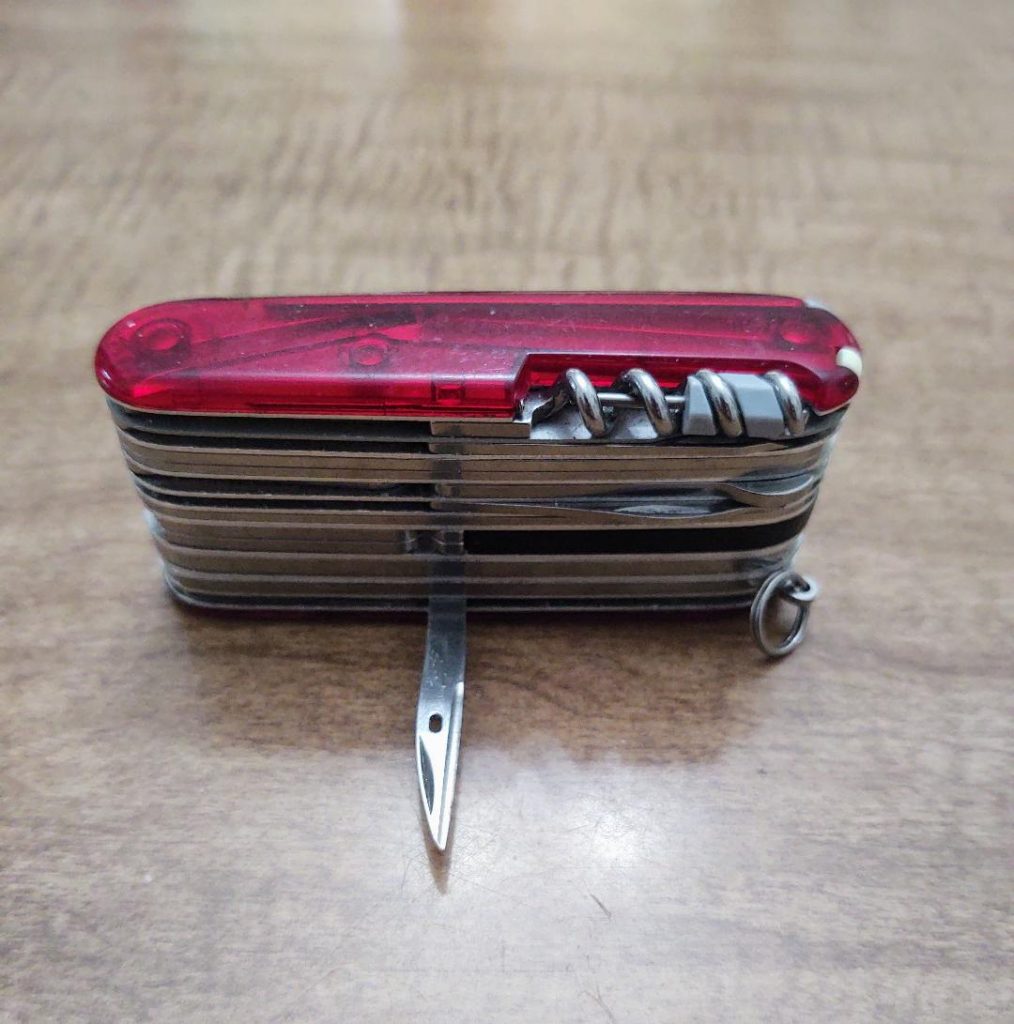
Threaded inside of the corkscrew is a miniature flathead screwdriver. It’s about the size of a screwdriver you find in an eyeglass repair kit and on a few occasions, I have used it to adjust my glasses.
Chisel
Other than its size, the chisel is very much like a regular wood chisel. It is completely flat on one side with a single beveled edge on the other side.
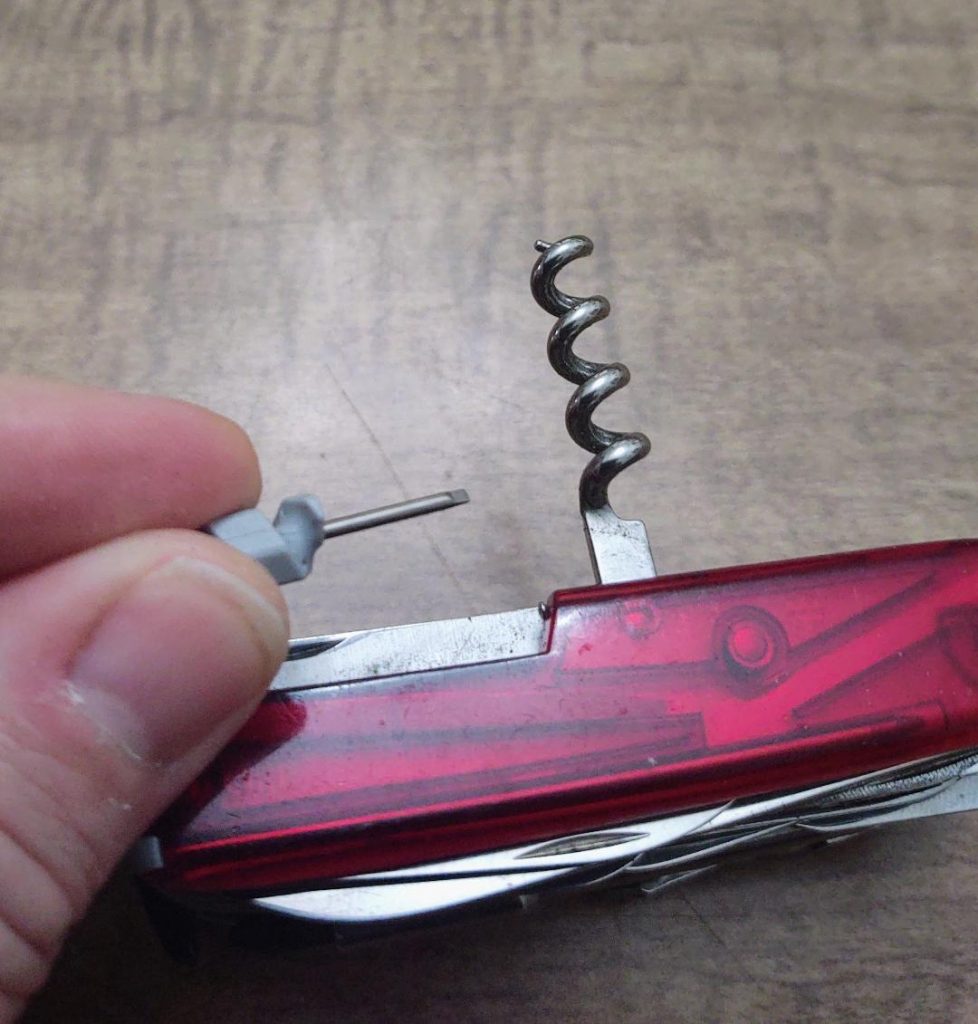
I have used it a few times when an outdoor wood project needed some finer detail work but given its position on the frame, it’s a bit awkward to use.
I think for most people this tool would be useful as a scrapper, removing a sticker from a tabletop for example, or as a small pry bar for gaining a tiny bit of leverage.
Pharmaceutical Spatula
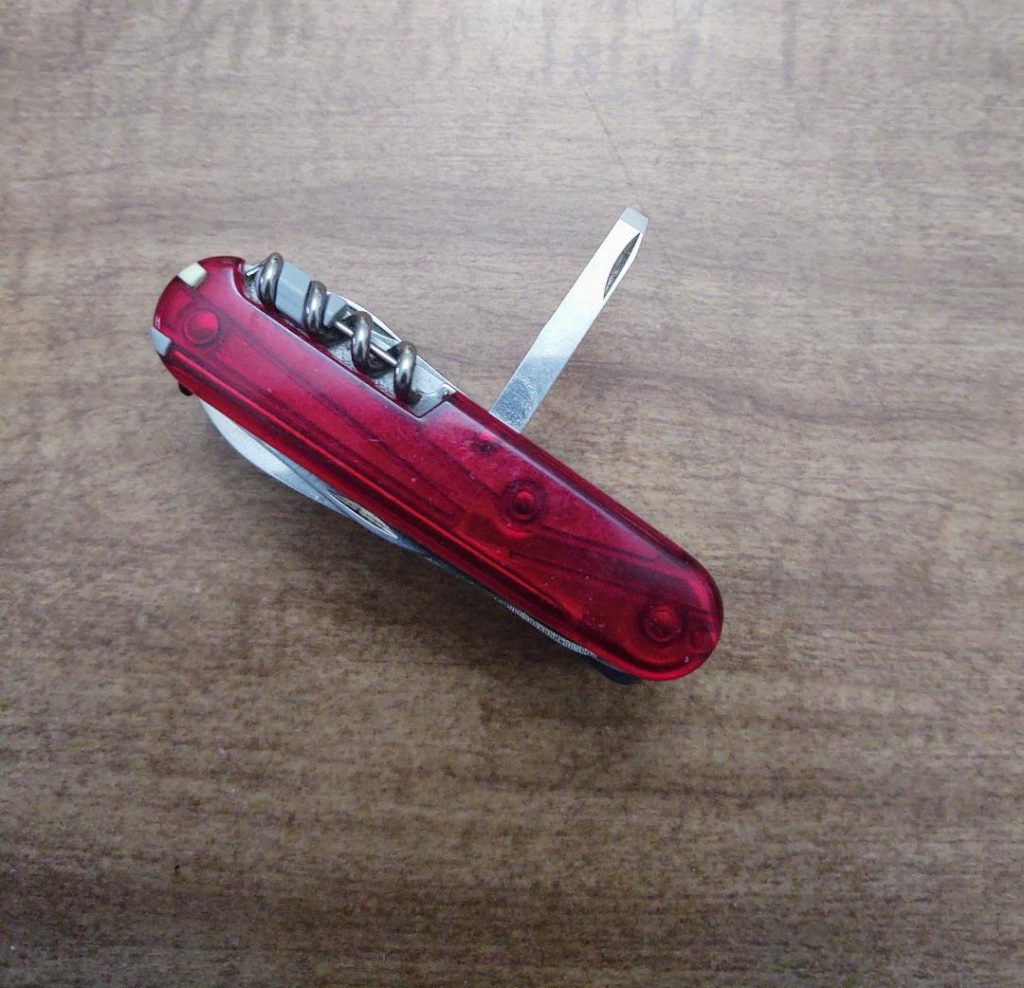
I have seen several comments about this tool where people say something like, “what in the heck am I supposed to do with this?”
Now, I will admit that at first glance this seems to be an odd tool to have on the XLT. I mean, how many of us need a pharmaceutical spatula?
However, that doesn’t mean it can’t be used for other purposes. A few things it can be used for include:
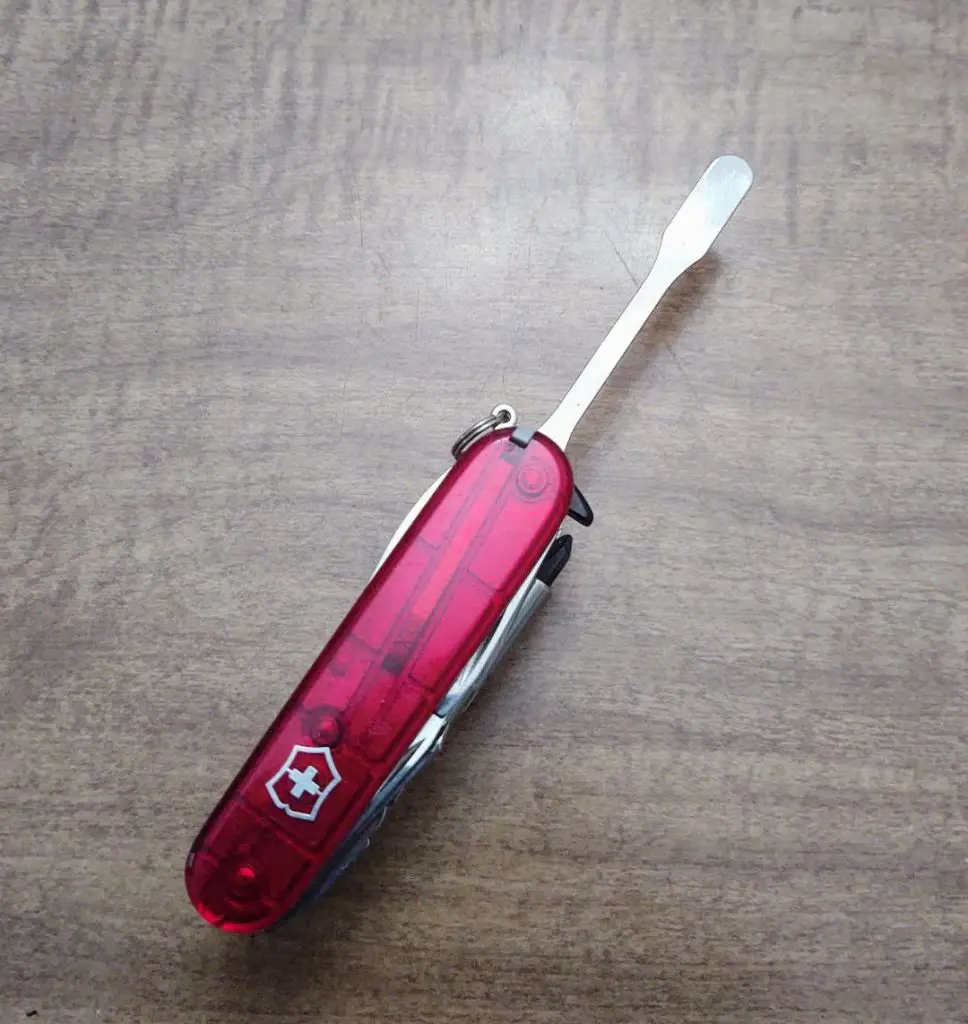
- As a butter knife for applying spreads to crackers and bread
- Applying bait trap triggers
- A tongue depressor
- A tool for pushing, rubbing, prying, where a blunt edge is needed
I am sure there are a lot of other things that it can be used for and if you think outside of the box, you will discover a few of them. While I rarely use this tool, there is some reason I’m glad it was included. I guess my gut may be telling me there is some future use I will discover for it.
Ruler/Hook Disgorger/Fish Scaler
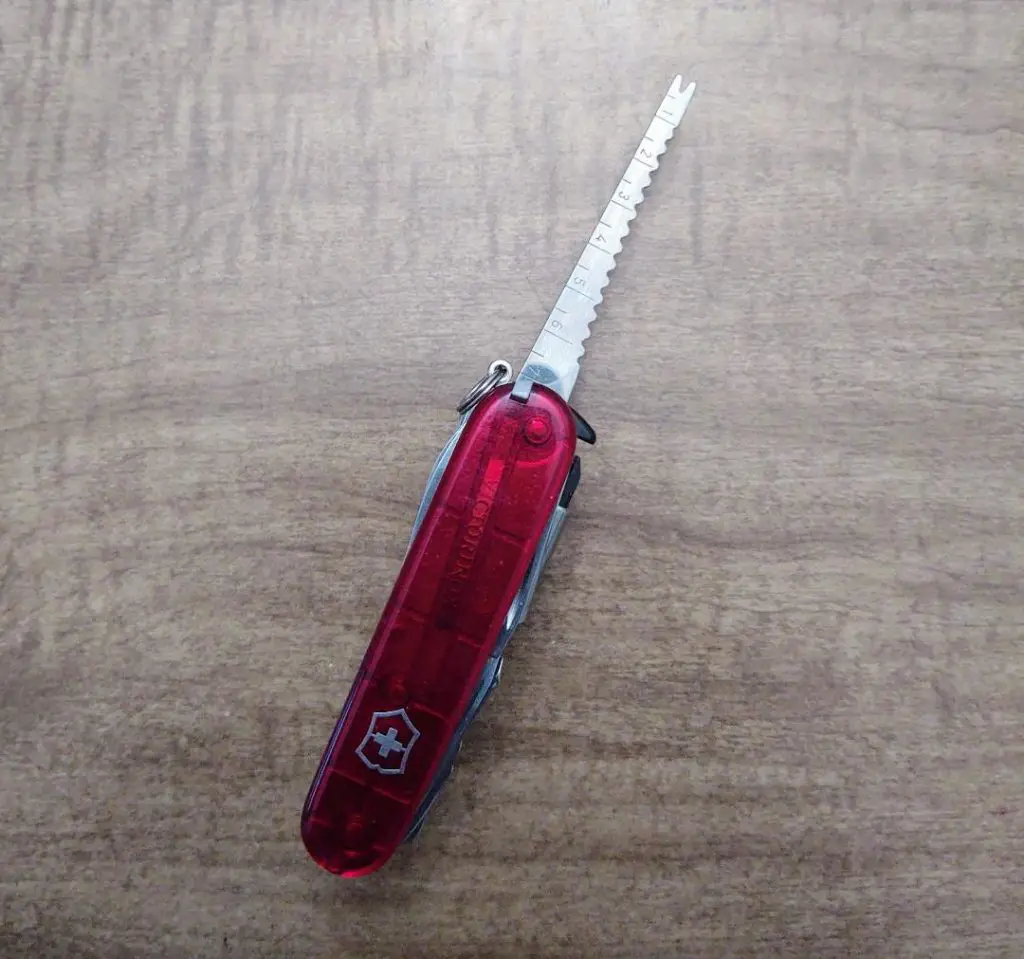
The tip of this tool is the hook disgorger, the wavy lines on the side is the fish scaler, and the ruler marks can be found on either side of the tool.
Unfortunately, I don’t get out fishing as much as I would like, but the times I have used the hook disgorger and scaler, they worked well. The ruler is nice for making small measurements and it can also be used as a line guide.
Is the Swiss Champ XLT a Good Survival Knife?
My answer to this question is both yes and no because it depends on your perspective of what a survival knife is and what you plan on doing with it.
Being a multitool, it is a “jack of all trades.” This means it is good at a lot of things but a master of none. I love multitools because they allow many tools to be carried efficiently and effectively when weight and storage space are a concern. It also excels at light to medium-duty tasks. In this regard, I think the Swiss Champ XLT is an excellent choice.
On the other side of the coin, many people demand a lot out of what they consider a survival knife to be. They want to be able to do things with it such as dig into soft and hard ground, break glass, baton cut wood, and all sorts of heavy-duty tasks. In this regard, I would not consider the XLT to be a good choice.
The silver lining though is that the XLT is small enough that it and a separate larger fixed blade could easily be carried. You can cover a lot of bases by carrying both a large knife and a small knife, which in the end makes you better prepared.
Swiss Champ XLT Pros and Cons
Pros
- A lot of tools in a small package
- Quality materials
- Great craftsmanship
- Small enough to fit in a pocket
- Four different blades
- Can be carried discreetly
Cons
- Rather pricey
- A bit bulky to carry in a pocket
- None of the tools are lockable
FAQs
The tools will still work without the spring, but it will require you to manually reopen the handle every time. You can go to Victorinox’s website where they do sell some replacement parts. Just be sure that the spring you order fits the knife model you have because there are a few different sizes of springs available.
Stainless steel is used in the construction of this knife which makes it resistant to rusting. As long as the knife is thoroughly dried off after use, you shouldn’t have to worry about it rusting.
Given all the folding tools it has, debris and lint can easily find their way into all the small crevices. I have found that a Q-tip or compressed air works well in cleaning out these spaces.
I would say no for younger kids simply due to the size of the XLT. I think it would be too bulky for small hands to handle properly and safely. However, for older kids like teenagers, this may not be an issue.
Verdict
I give the Swiss Champ XLT a big thumbs up. It’s made from quality materials and put together with amazing craftsmanship by a company that has been around for a long time.
I think this knife is perfect for someone who likes to tinker and keep their hands busy or for someone who is not sure what they will run into indoors or outdoors.
Over, the last year I have used the Swiss Champ XLT both outdoors and indoors and it has performed great in both environments. It does have a few tools that I do not use all that often, but you will find that with almost any multitool you get.
I have done all sorts of things with it from adjusting hardware, cutting open food containers, grabbing items with the pliers, food preparation, pruned trees and plants around the house, repaired gear with the reamer, carried or moved things with the multipurpose hook, and when the conditions were just right, I have started many fires with it.
About the only real downfall that I see to the knife is the price tag attached to it but with Swiss Army Knives you truly get what you pay for. If you are looking for a well-built, durable, and versatile pocketknife/multitool I would highly encourage you to take a look at the Swiss Champ XLT.
Also, if you enjoy Swiss Army Knives as much as I do and are looking for some different ways to use them, check out my book Swiss Army Knife Camping and Outdoor Survival Guide. Thanks for reading and I hope this review was helpful.
Do you have any experience with the Swiss Champ XLT or have questions about it? If so, then sound off in the comment section below and let us know!
- Sport type: Camping & Hiking
- FIT FOR ALL TASKS: At their heart, all our pocket knives are a survival tool; multitaskers that...
Last update on 2024-04-22 at 23:12 / Affiliate links / Images from Amazon Product Advertising API



